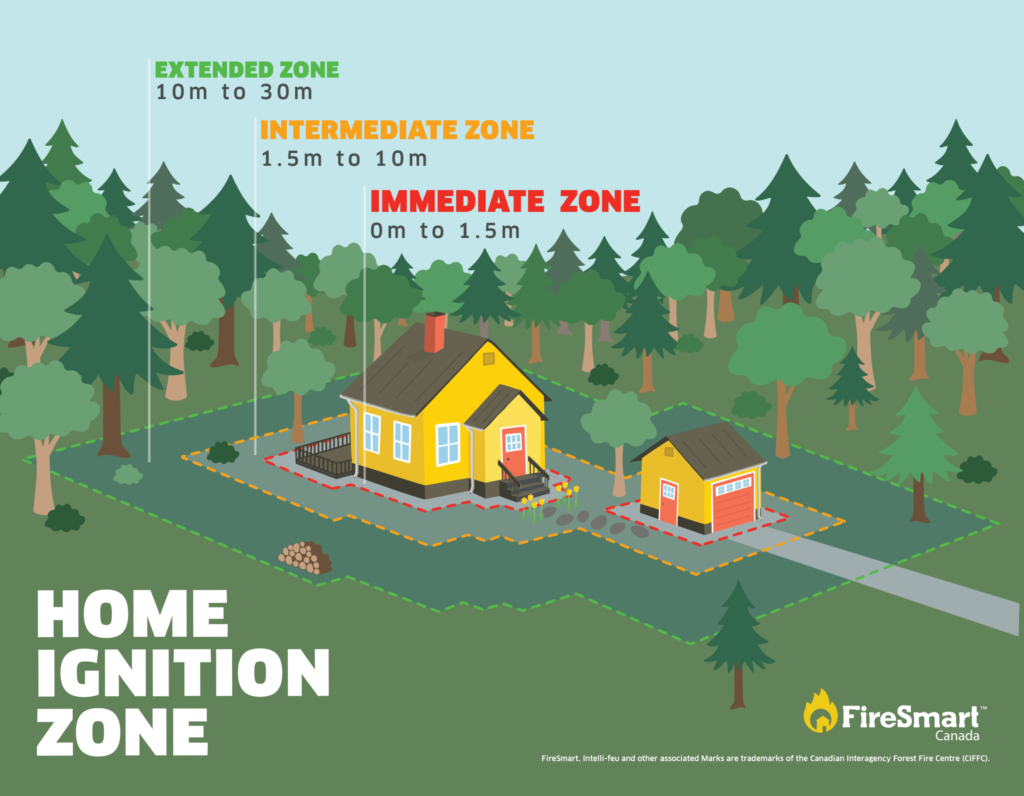We want to lessen the community impacts in the event of a wildfire in Sturgeon County, and we need your help. We encourage you to take actions now to increase the chances of your home surviving a wildfire.
By making your home FireSmart – which means making simple choices when maintaining your property, landscaping your yard, or undertaking a renovation or construction project – you can lessen the chance that your home will be lost or damaged by wildfire.
The Institute for Catastrophic Loss Reduction found that during the Fort McMurray wildfire in 2016, FireSmart homes were significantly less likely to have been lost. In fact, four of every five homes that survived the fire were considered FireSmart.
Get FireSmart: Information Sessions
Get the information you need to protect your home from wildfire and to prepare for the 2024 fire season.
Tuesday, April 16
6:30 to 8 p.m.
Pinewood Community Hall
305 Maple Drive in Opal (Highway 651 between Range Road 233 and 232)
Thursday, April 18
6:30 to 8 p.m.
Calahoo Community Hall
#9 54500 Range Road 275 in Calahoo
Home/yard maintenance
- Remove items that can burn – like dried branches, leaves, lawn furniture, propane tanks, firewood and debris – from within 1.5 metres (five feet) of your home, shed and other buildings, and from under your deck or porch. Consider screening or boxing in areas below decks to prevent debris from gathering.
- Remove and properly dispose of debris, leaves and other material from your roof, gutters and decks.
- Keep your lawn watered and maintained. Ideally, grass and weeds should be less than 10 centimetres (four inches) high.
- Add non-combustible three-millimetre screens to external vents (except dryer vents) to keep embers out.
- Prune trees so the lowest branches are at least two metres (six feet) from the ground. Make sure branches are at least 1.5 metres (five feet) from your home, deck or fence.
- Move firewood at least 10 metres (33 feet) from your home.
Consult the FireSmart Begins at Home Guide for more great tips!
Landscaping
- Plant wildfire-resistant plants and trees. Deciduous (leafy) trees are better options than coniferous (evergreen) trees. Consult the FireSmart Guide to Landscaping for information about which plants and trees would be best.
- Space trees, particularly evergreens which are more flammable, at least three metres (10 feet) apart to slow the spread of wildfire.
- Avoid using bark mulch, which is highly flammable.
Farm/acreage maintenance
FireSmart Alberta suggests the following actions:
- Cut your grass. Ideally, grass and weeds should be less than 10 centimetres (four inches) high. Mowing grass short in the fall is especially helpful and can slow wildfire spread.
- Till around your home and outbuildings to prevent the spread of fire into your yard.
- Clean up the down and dead wood in your yard, shelter belts, woodlots and near your home and fences.
- In the spring, check for trees and branches that may have fallen on power lines over the winter. Check your poles for rot and contact the local utility provider if you have concerns.
Consult the FireSmart Farm and Acreage guide for more actions you can take.
Renovation and construction
If you are doing construction or upgrades to your home, consider using fire-rated materials and making simple adjustments – like installing non-combustible vents, installing a screen on your gutters, installing a spark arrester on your chimney and more – to reduce fire risk. Consult the FireSmart Home Development Guide for more information.
Minimizing the threats on your property

Immediate zone (up to 1.5 metres around your home)
The immediate zone is a non-combustible area that starts at the house and extends to 1.5 metres around the home and attached structures, including decks. Reduce the chance of wind-blown embers igniting your home by starting with these proactive steps:
- Choose non-combustible building materials when constructing or renovating your home.
- Clear vegetation and combustible material down to mineral soil and cover with non-combustible materials like gravel, brick, or concrete.
- Avoid planting woody shrubs or trees. If any are present, prune and maintain them regularly.
Intermediate zone (1.5 to 10 metres)
Elements in the intermediate zone are managed so they don’t transmit fire to your home. Here are a few actions you can take to reduce your home’s vulnerability:
- Plant fire-resistant vegetation and select non-combustible landscaping materials.
- Avoid incorporating any woody debris, including mulch.
- Keep combustible items like firewood piles, construction materials, patio furniture, tools, and decorative pieces out of this zone.
- Move trailers, recreational vehicles, storage sheds, and other combustible structures into the extended zone. If that’s not possible, store firewood inside your mitigated garage, shed, or other ember resistant structures.
- Create a non-combustible ground cover, like a gravel pad, underneath and 1.5 metres around trailers, recreational vehicles, and sheds.
Extended zone (10 to 30 metres)
The goal in the extended zone is not to eliminate fire, but to reduce its intensity. If your property extends into this zone, a few important steps you can take include:
- Selectively remove evergreen trees to create at least three metres of horizontal space between the single or grouped tree crowns.
- Remove all branches to a height of two metres from the ground.
- Regularly clean up accumulations of fallen branches, dry grass, and needles to eliminate potential surface fuels.
- Continue to apply these principles if your property extends beyond 30 metres. Work with your neighbours in overlapping zones and seek guidance from a forest professional if affected by other conditions like steep slopes.

